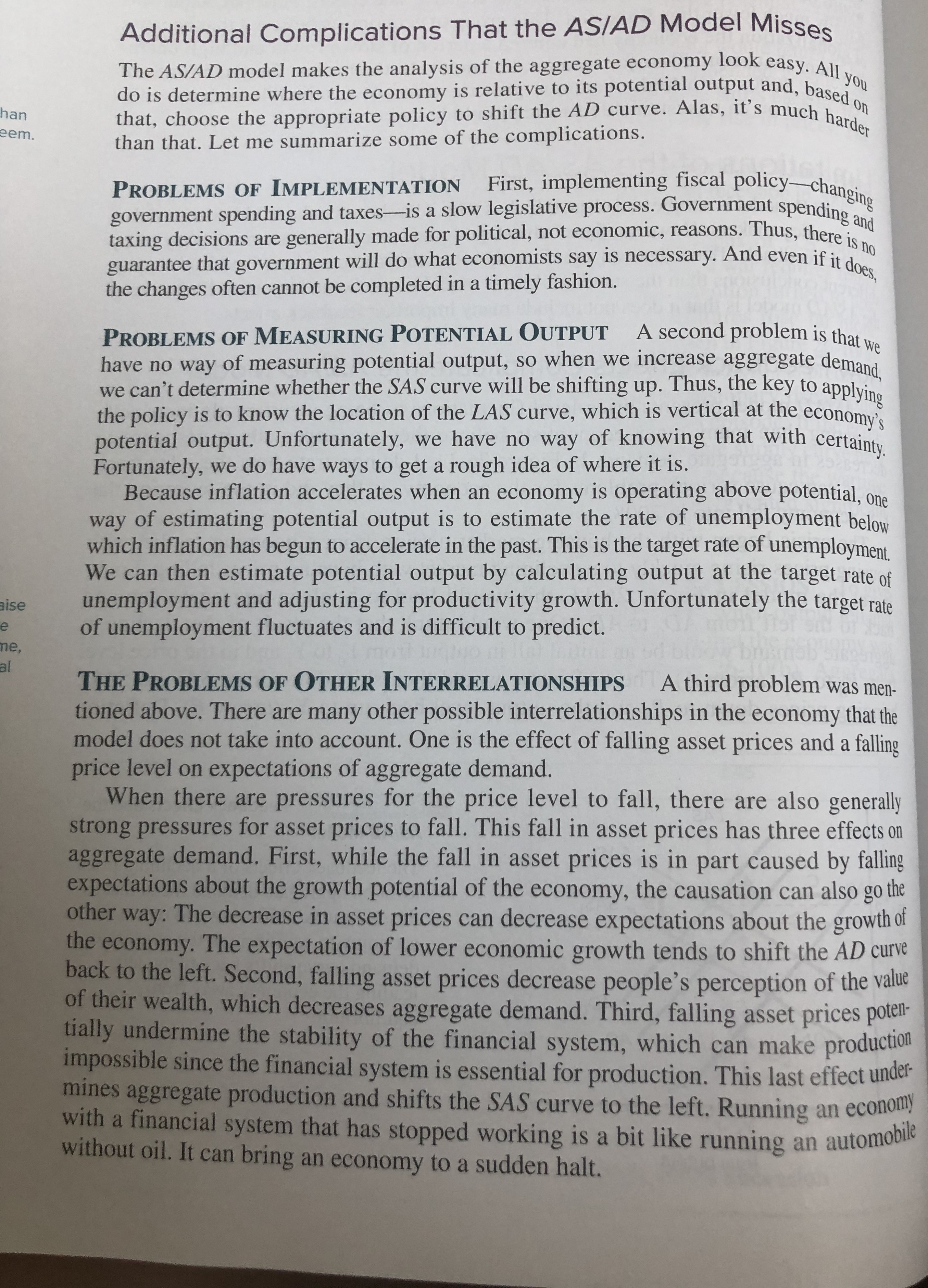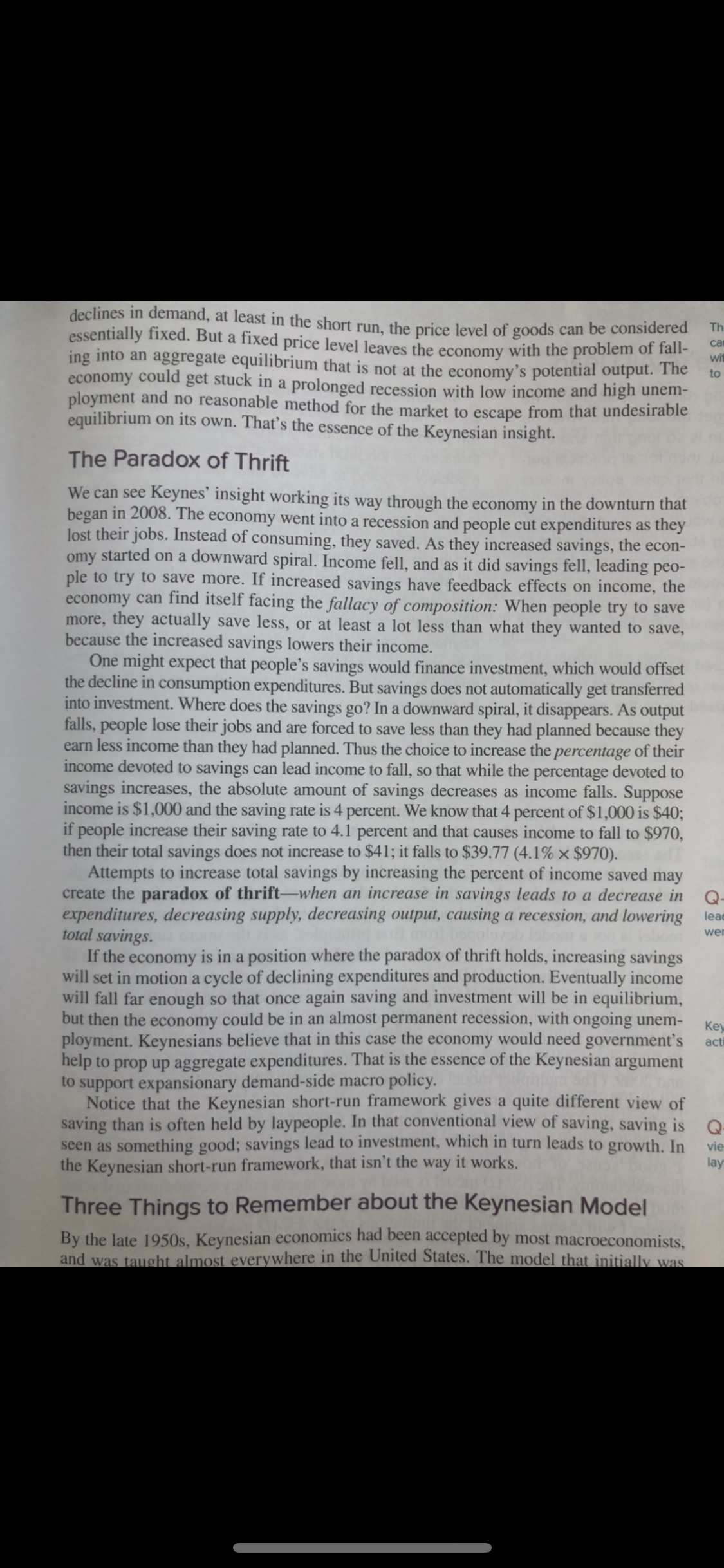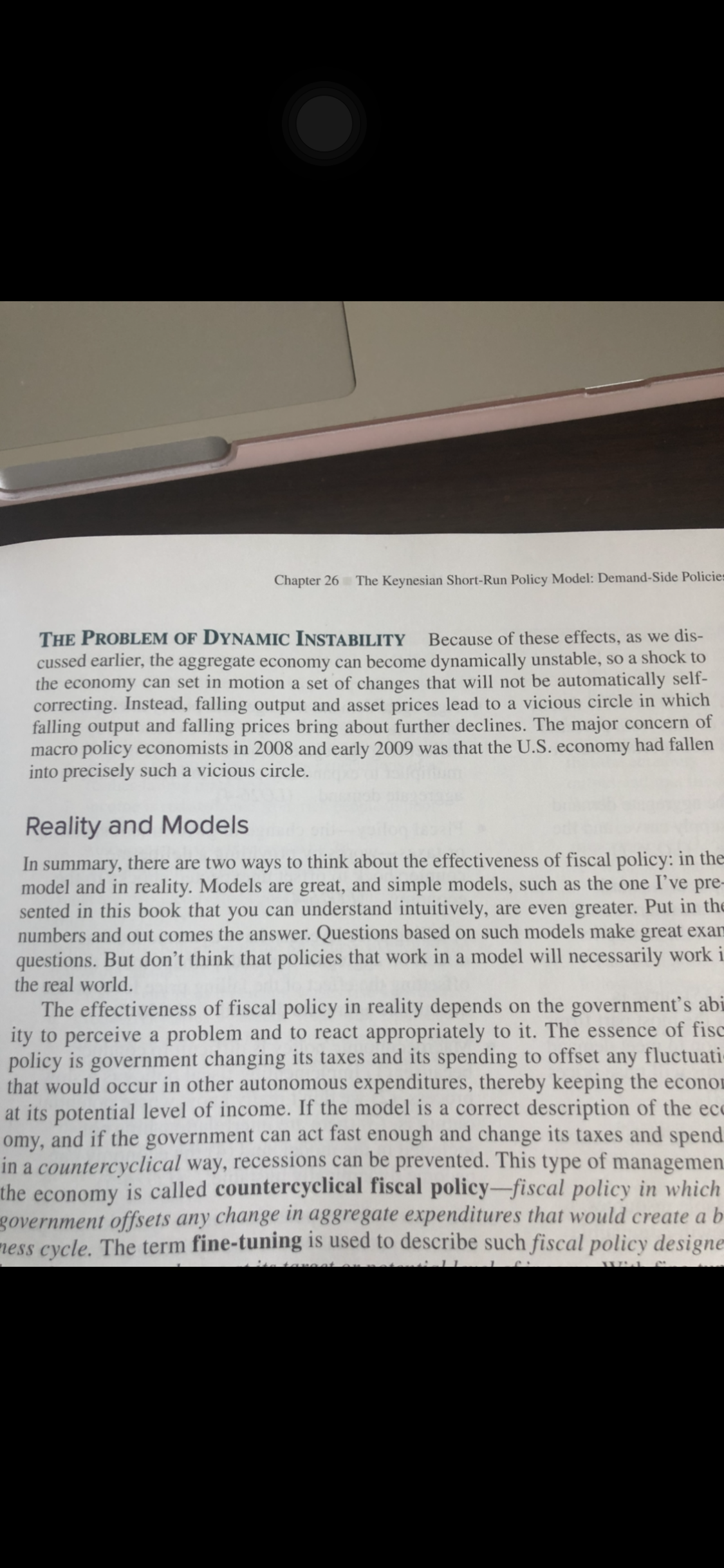Additional Complications That the AS/AD Model Misses The AS/AD model makes the analysis of the aggregate economy look easy. All you do is determine where the economy is relative to its potential output and, based of nan eem that, choose the appropriate policy to shift the AD curve. Alas, it's much hard than that. Let me summarize some of the complications. PROBLEMS OF IMPLEMENTATION First, implementing fiscal policy-changing government spending and taxes-is a slow legislative process. Government spending and taxing decisions are generally made for political, not economic, reasons. Thus, there is no guarantee that government will do what economists say is necessary. And even if it does the changes often cannot be completed in a timely fashion. PROBLEMS OF MEASURING POTENTIAL OUTPUT A second problem is that we have no way of measuring potential output, so when we increase aggregate demand we can't determine whether the SAS curve will be shifting up. Thus, the key to applying the policy is to know the location of the LAS curve, which is vertical at the economy's potential output. Unfortunately, we have no way of knowing that with certainty. Fortunately, we do have ways to get a rough idea of where it is. Because inflation accelerates when an economy is operating above potential, one way of estimating potential output is to estimate the rate of unemployment below which inflation has begun to accelerate in the past. This is the target rate of unemployment. We can then estimate potential output by calculating output at the target rate of ise unemployment and adjusting for productivity growth. Unfortunately the target rate ne, of unemployment fluctuates and is difficult to predict. THE PROBLEMS OF OTHER INTERRELATIONSHIPS A third problem was men- tioned above. There are many other possible interrelationships in the economy that the model does not take into account. One is the effect of falling asset prices and a falling price level on expectations of aggregate demand. When there are pressures for the price level to fall, there are also generally strong pressures for asset prices to fall. This fall in asset prices has three effects on aggregate demand. First, while the fall in asset prices is in part caused by falling expectations about the growth potential of the economy, the causation can also go the other way: The decrease in asset prices can decrease expectations about the growth of the economy. The expectation of lower economic growth tends to shift the AD curve back to the left. Second, falling asset prices decrease people's perception of the value of their wealth, which decreases aggregate demand. Third, falling asset prices poten- tially undermine the stability of the financial system, which can make production impossible since the financial system is essential for production. This last effect under mines aggregate production and shifts the SAS curve to the left. Running an economy with a financial system that has stopped working is a bit like running an automobile without oil. It can bring an economy to a sudden halt.declines in demand, at least in the short run, the price level of goods can be considered essentially fixed. But a fixed price level leaves the economy with the problem of fall- Th ing into an aggregate equilibrium that is not at the economy's potential output. The economy could get stuck in a prolonged recession with low income and high unem to ployment and no reasonable method for the market to escape from that undesirable equilibrium on its own. That's the essence of the Keynesian insight. The Paradox of Thrift We can see Keynes' insight working its way through the economy in the downturn that began in 2008. The economy went into a recession and people cut expenditures as they lost their jobs. Instead of consuming, they saved. As they increased savings, the econ- omy started on a downward spiral. Income fell, and as it did savings fell, leading peo- ple to try to save more. If increased savings have feedback effects on income, the economy can find itself facing the fallacy of composition: When people try to save more, they actually save less, or at least a lot less than what they wanted to save, because the increased savings lowers their income. One might expect that people's savings would finance investment, which would offset the decline in consumption expenditures. But savings does not automatically get transferred into investment. Where does the savings go? In a downward spiral, it disappears. As output falls, people lose their jobs and are forced to save less than they had planned because they earn less income than they had planned. Thus the choice to increase the percentage of their income devoted to savings can lead income to fall, so that while the percentage devoted to savings increases, the absolute amount of savings decreases as income falls. Suppose income is $1,000 and the saving rate is 4 percent. We know that 4 percent of $1,000 is $40; if people increase their saving rate to 4.1 percent and that causes income to fall to $970, then their total savings does not increase to $41; it falls to $39.77 (4.1% x $970). Attempts to increase total savings by increasing the percent of income saved may create the paradox of thrift-when an increase in savings leads to a decrease in Q expenditures, decreasing supply, decreasing output, causing a recession, and lowering lea total savings. we If the economy is in a position where the paradox of thrift holds, increasing savings will set in motion a cycle of declining expenditures and production. Eventually income will fall far enough so that once again saving and investment will be in equilibrium, but then the economy could be in an almost permanent recession, with ongoing unem- ployment. Keynesians believe that in this case the economy would need government's Ke act help to prop up aggregate expenditures. That is the essence of the Keynesian argument to support expansionary demand-side macro policy. Notice that the Keynesian short-run framework gives a quite different view of saving than is often held by laypeople. In that conventional view of saving, saving is seen as something good; savings lead to investment, which in turn leads to growth. In Q vie the Keynesian short-run framework, that isn't the way it works. lay Three Things to Remember about the Keynesian Model By the late 1950s, Keynesian economics had been accepted by most macroeconomists, and was taught almost everywhere in the United States. The model that initially wasChapter 26 The Keynesian Short-Run Policy Model: Demand-Side Policiel TEE 1'30an or DYNAMIC lusrnm Because of these effects. as we dis- cussed earlier. the aggregate economy can become dynamically unstable, so a shock to the economy can set in motion a set of changes that will not be automatically self- COeCI-ig- Instead, falling output and asset prices lead to a vicious circle in which falling output and falling prices bring about further declines. The major concern of macro policy economists in 2008 and early 2009 was that the U.S. economy had fallen into precisely such a vicious circle. Reality and Models In summary, there are two ways to think about the effectiveness of scal policy: in the model and in reality. Models are great, and simple models, such as the one I've pre- sented in this book that y0u can understand intuitively, are even greater. Put in tht numbers and out comes the answer. Questions based on such models make great exam questions. But don't think that policies that work in a model will necessarily work i the teal world. The effectiveness of fiscal policy in reality depends on the government's abi ity to perceive a problem and to react appropriately to it. The essence of fisc policy is government changing its taxes and its spending to offset any fluctuati that would occur in other autonomous expenditures. thereby keeping the econo: qt its" potential level of income. If the model is a correct description of the eel ; . and if the government can act fast enough and change its taxes and spend myclical way. recessions can be prevented. This type of managemen y is called countercycllcal scal policyscal policy in which .. 0mm any change m aggregate expenditures that would create a b in, mm fine-tum 18 tiled to describe such scal policy designs









